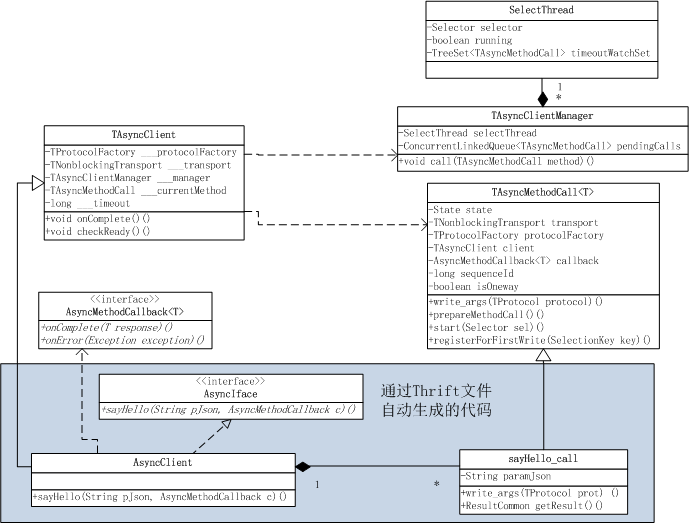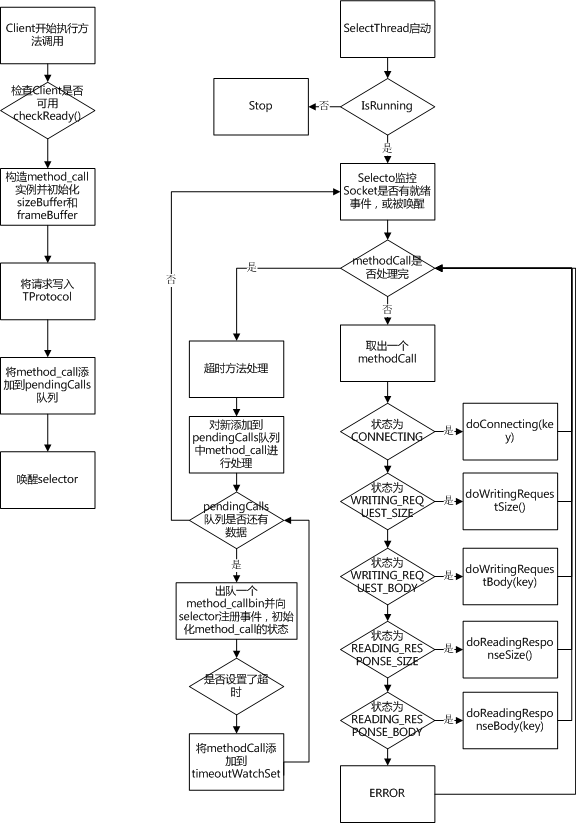RPC-Thrift(四)
Client
Thrift客户端有两种:同步客户端和异步客户端。
同步客户端
同步客户端比较简单,以RPC-Thrift(一)中的的例子为基础进行研究源码,先看一下类图。

TServiceClient:用于以同步方式与TService进行通信;
Iface接口和Client类都是通过Thrift文件自动生成的代码。
TServiceClient
TServiceClient定义了基础的向Server发送请求和从Server接收响应的方法。
public abstract class TServiceClient {
public TServiceClient(TProtocol prot) {
this(prot, prot);
}
public TServiceClient(TProtocol iprot, TProtocol oprot) {
iprot_ = iprot;
oprot_ = oprot;
}
protected TProtocol iprot_;//输入TProtocol
protected TProtocol oprot_;//输出TProtocol
protected int seqid_;//序列号
public TProtocol getInputProtocol() {
return this.iprot_;
}
public TProtocol getOutputProtocol() {
return this.oprot_;
}
//向Server发送请求
protected void sendBase(String methodName, TBase args) throws TException {
//写消息头,seqid_只是简单的++,非线程安全,接收响应时要进行seqid_的校验
oprot_.writeMessageBegin(new TMessage(methodName, TMessageType.CALL, ++seqid_));
args.write(oprot_);//写参数
oprot_.writeMessageEnd();
oprot_.getTransport().flush();//发送
}
//从Server接收响应
protected void receiveBase(TBase result, String methodName) throws TException {
TMessage msg = iprot_.readMessageBegin();//读消息头,若没有数据一直等待,详见TTransport的实现
if (msg.type == TMessageType.EXCEPTION) {
//异常消息通过TApplicationException读取
TApplicationException x = TApplicationException.read(iprot_);
iprot_.readMessageEnd();
throw x;
}
if (msg.seqid != seqid_) {
//序列号不一致报异常
throw new TApplicationException(TApplicationException.BAD_SEQUENCE_ID, methodName + " failed: out of sequence response");
}
result.read(iprot_);//读数据,由其result子类实现
iprot_.readMessageEnd();
}
}
Iface
public interface Iface {
//thrift中定义的方法
public ResultCommon sayHello(String paramJson) throws org.apache.thrift.TException;
}
Client
public static class Client extends org.apache.thrift.TServiceClient implements Iface {
//Client工厂类
public static class Factory implements org.apache.thrift.TServiceClientFactory<Client> {
public Factory() {}
public Client getClient(org.apache.thrift.protocol.TProtocol prot) {
return new Client(prot);
}
public Client getClient(org.apache.thrift.protocol.TProtocol iprot, org.apache.thrift.protocol.TProtocol oprot) {
return new Client(iprot, oprot);
}
}
public Client(org.apache.thrift.protocol.TProtocol prot)
{
super(prot, prot);
}
public Client(org.apache.thrift.protocol.TProtocol iprot, org.apache.thrift.protocol.TProtocol oprot) {
super(iprot, oprot);
}
//sayHello方法调用入口
public ResultCommon sayHello(String paramJson) throws org.apache.thrift.TException
{
send_sayHello(paramJson);//发送请求
return recv_sayHello();//接收响应
}
//发送请求
public void send_sayHello(String paramJson) throws org.apache.thrift.TException
{
sayHello_args args = new sayHello_args();//组装参数
args.setParamJson(paramJson);
sendBase("sayHello", args);//调用父类的sendBase方法发送请求
}
//接收响应
public ResultCommon recv_sayHello() throws org.apache.thrift.TException
{
sayHello_result result = new sayHello_result();
receiveBase(result, "sayHello");//调用父类的receiveBase方法发送请求
if (result.isSetSuccess()) {
return result.success;
}
throw new org.apache.thrift.TApplicationException(org.apache.thrift.TApplicationException.MISSING_RESULT, "sayHello failed: unknown result");
}
}
异步客户端
异步客户端实现比较复杂,通过回调实现,先看一个异步客户端的例子。异步客户端需要使用TNonblockingSocket,通过AsyncMethodCallback接收服务端的回调。
String paramJson = "{\"wewe\":\"111\"}";
TNonblockingSocket tNonblockingSocket = new TNonblockingSocket("127.0.0.1", 8090);//使用非阻塞TNonblockingSocket
TAsyncClientManager tAsyncClientManager = new TAsyncClientManager();
HelloService.AsyncClient asyncClient = new HelloService.AsyncClient.Factory(tAsyncClientManager, new TBinaryProtocol.Factory()).getAsyncClient(tNonblockingSocket);
asyncClient.sayHello(paramJson, new AsyncMethodCallback<HelloService.AsyncClient.sayHello_call>() {
@Override
public void onError(Exception exception) {
//...
}
@Override
public void onComplete(sayHello_call response) {
ResultCommon resultCommon = response.getResult();
System.out.println(resultCommon.getDesc());
}
});
涉及到的类结构图如下:

TAsyncClient:异步客户端抽象类,通过Thrift文件生成的AsyncClient需继承该类;
TAsyncClientManager:异步客户端管理类,包含一个selector线程,用于转换方法调用对象;
TAsyncMethodCall:封装了异步方法调用,Thrift文件定义的所有方法都会在AsyncClient中生成对应的继承于TAsyncMethodCall的内部类(如sayHello_call);
AsyncMethodCallback:接收服务端回调的接口,用户需要定义实现该接口的类。
TAsyncClient
TAsyncClient为异步客户端提供了公共的属性和方法。
public abstract class TAsyncClient {
protected final TProtocolFactory ___protocolFactory;
protected final TNonblockingTransport ___transport;
protected final TAsyncClientManager ___manager;//异步客户端管理类
protected TAsyncMethodCall ___currentMethod;//异步方法调用
private Exception ___error;
private long ___timeout;
public TAsyncClient(TProtocolFactory protocolFactory, TAsyncClientManager manager, TNonblockingTransport transport) {
this(protocolFactory, manager, transport, 0);
}
public TAsyncClient(TProtocolFactory protocolFactory, TAsyncClientManager manager, TNonblockingTransport transport, long timeout) {
this.___protocolFactory = protocolFactory;
this.___manager = manager;
this.___transport = transport;
this.___timeout = timeout;
}
public TProtocolFactory getProtocolFactory() {
return ___protocolFactory;
}
public long getTimeout() {
return ___timeout;
}
public boolean hasTimeout() {
return ___timeout > 0;
}
public void setTimeout(long timeout) {
this.___timeout = timeout;
}
//客户端是否处于异常状态
public boolean hasError() {
return ___error != null;
}
public Exception getError() {
return ___error;
}
//检查是否准备就绪,如果当前Cilent正在执行一个方法或处于error状态则报异常
protected void checkReady() {
if (___currentMethod != null) {
throw new IllegalStateException("Client is currently executing another method: " + ___currentMethod.getClass().getName());
}
if (___error != null) {
throw new IllegalStateException("Client has an error!", ___error);
}
}
//执行完成时delegate方法会调用该方法,将___currentMethod置为null
protected void onComplete() {
___currentMethod = null;
}
//执行出现异常时delegate方法会调用该方法,
protected void onError(Exception exception) {
___transport.close();//关闭连接
___currentMethod = null;//将___currentMethod置为null
___error = exception;//异常信息
}
}
AsyncClient
AsyncClient类是通过Thrift文件自动生成的,在该类中含有每个方法的调用入口,并且为每个方法生成了一个方法调用类方法名_call,如sayHello_call。sayHello_call实现了父类TAsyncMethodCall的连个抽象方法:write_args和getResult,因为每个方法的参数和返回值不同,所以这两个方法需要具体子类实现。
public static class AsyncClient extends org.apache.thrift.async.TAsyncClient implements AsyncIface {
//AsyncClient工厂类
public static class Factory implements org.apache.thrift.async.TAsyncClientFactory<AsyncClient> {
private org.apache.thrift.async.TAsyncClientManager clientManager;
private org.apache.thrift.protocol.TProtocolFactory protocolFactory;
public Factory(org.apache.thrift.async.TAsyncClientManager clientManager, org.apache.thrift.protocol.TProtocolFactory protocolFactory) {
this.clientManager = clientManager;
this.protocolFactory = protocolFactory;
}
public AsyncClient getAsyncClient(org.apache.thrift.transport.TNonblockingTransport transport) {
return new AsyncClient(protocolFactory, clientManager, transport);
}
}
public AsyncClient(org.apache.thrift.protocol.TProtocolFactory protocolFactory, org.apache.thrift.async.TAsyncClientManager clientManager, org.apache.thrift.transport.TNonblockingTransport transport) {
super(protocolFactory, clientManager, transport);
}
//sayHello方法调用入口
public void sayHello(String paramJson, org.apache.thrift.async.AsyncMethodCallback<sayHello_call> resultHandler) throws org.apache.thrift.TException {
checkReady();//检查当前Client是否可用
//创建方法调用实例
sayHello_call method_call = new sayHello_call(paramJson, resultHandler, this, ___protocolFactory, ___transport);
this.___currentMethod = method_call;
//调用TAsyncClientManager的call方法
___manager.call(method_call);
}
public static class sayHello_call extends org.apache.thrift.async.TAsyncMethodCall {
private String paramJson;
public sayHello_call(String paramJson, org.apache.thrift.async.AsyncMethodCallback<sayHello_call> resultHandler, org.apache.thrift.async.TAsyncClient client, org.apache.thrift.protocol.TProtocolFactory protocolFactory, org.apache.thrift.transport.TNonblockingTransport transport) throws org.apache.thrift.TException {
super(client, protocolFactory, transport, resultHandler, false);
this.paramJson = paramJson;
}
//发送请求
public void write_args(org.apache.thrift.protocol.TProtocol prot) throws org.apache.thrift.TException {
prot.writeMessageBegin(new org.apache.thrift.protocol.TMessage("sayHello", org.apache.thrift.protocol.TMessageType.CALL, 0));
sayHello_args args = new sayHello_args();
args.setParamJson(paramJson);
args.write(prot);
prot.writeMessageEnd();
}
//获取返回结果
public ResultCommon getResult() throws org.apache.thrift.TException {
if (getState() != org.apache.thrift.async.TAsyncMethodCall.State.RESPONSE_READ) {
throw new IllegalStateException("Method call not finished!");
}
org.apache.thrift.transport.TMemoryInputTransport memoryTransport = new org.apache.thrift.transport.TMemoryInputTransport(getFrameBuffer().array());
org.apache.thrift.protocol.TProtocol prot = client.getProtocolFactory().getProtocol(memoryTransport);
return (new Client(prot)).recv_sayHello();
}
}
}
TAsyncClientManager
TAsyncClientManager是异步客户端管理类,它为维护了一个待处理的方法调用队列pendingCalls,并通过SelectThread线程监听selector事件,当有就绪事件时进行方法调用的处理。
public class TAsyncClientManager {
private static final Logger LOGGER = LoggerFactory.getLogger(TAsyncClientManager.class.getName());
private final SelectThread selectThread;
//TAsyncMethodCall待处理队列
private final ConcurrentLinkedQueue<TAsyncMethodCall> pendingCalls = new ConcurrentLinkedQueue<TAsyncMethodCall>();
//初始化TAsyncClientManager,新建selectThread线程并启动
public TAsyncClientManager() throws IOException {
this.selectThread = new SelectThread();
selectThread.start();
}
//方法调用
public void call(TAsyncMethodCall method) throws TException {
if (!isRunning()) {
throw new TException("SelectThread is not running");
}
method.prepareMethodCall();//做方法调用前的准备
pendingCalls.add(method);//加入待处理队列
selectThread.getSelector().wakeup();//唤醒selector,很重要,因为首次执行方法调用时select Thread还阻塞在selector.select()上
}
public void stop() {
selectThread.finish();
}
public boolean isRunning() {
return selectThread.isAlive();
}
//SelectThread线程类,处理方法调用的核心
private class SelectThread extends Thread {
private final Selector selector;
private volatile boolean running;
private final TreeSet<TAsyncMethodCall> timeoutWatchSet = new TreeSet<TAsyncMethodCall>(new TAsyncMethodCallTimeoutComparator());
public SelectThread() throws IOException {
this.selector = SelectorProvider.provider().openSelector();
this.running = true;
this.setName("TAsyncClientManager#SelectorThread " + this.getId());
setDaemon(true);//非守护线程
}
public Selector getSelector() {
return selector;
}
public void finish() {
running = false;
selector.wakeup();
}
public void run() {
while (running) {
try {
try {
if (timeoutWatchSet.size() == 0) {
//如果超时TAsyncMethodCall监控集合为空,直接无限期阻塞监听select()事件。TAsyncClientManager刚初始化时是空的
selector.select();
} else {
//如果超时TAsyncMethodCall监控集合不为空,则计算Set中第一个元素的超时时间戳是否到期
long nextTimeout = timeoutWatchSet.first().getTimeoutTimestamp();
long selectTime = nextTimeout - System.currentTimeMillis();
if (selectTime > 0) {
//还没有到期,超时监听select()事件,超过selectTime自动唤醒selector
selector.select(selectTime);
} else {
//已经到期,立刻监听select()事件,不会阻塞selector
selector.selectNow();
}
}
} catch (IOException e) {
LOGGER.error("Caught IOException in TAsyncClientManager!", e);
}
//监听到就绪事件或者selector被唤醒会执行到此处
transitionMethods();//处理就绪keys
timeoutMethods();//超时方法调用处理
startPendingMethods();//处理pending的方法调用
} catch (Exception exception) {
LOGGER.error("Ignoring uncaught exception in SelectThread", exception);
}
}
}
//监听到就绪事件或者selector被唤醒,如果有就绪的SelectionKey就调用methodCall.transition(key);
private void transitionMethods() {
try {
Iterator<SelectionKey> keys = selector.selectedKeys().iterator();
while (keys.hasNext()) {
SelectionKey key = keys.next();
keys.remove();
if (!key.isValid()) {
//跳过无效key,方法调用出现异常或key被取消等会导致无效key
continue;
}
TAsyncMethodCall methodCall = (TAsyncMethodCall)key.attachment();
//调用methodCall的transition方法,执行相关的动作并将methodCall的状态转换为下一个状态
methodCall.transition(key);
//如果完成或发生错误,从timeoutWatchSet删除该methodCall
if (methodCall.isFinished() || methodCall.getClient().hasError()) {
timeoutWatchSet.remove(methodCall);
}
}
} catch (ClosedSelectorException e) {
LOGGER.error("Caught ClosedSelectorException in TAsyncClientManager!", e);
}
}
//超时方法调用处理
private void timeoutMethods() {
Iterator<TAsyncMethodCall> iterator = timeoutWatchSet.iterator();
long currentTime = System.currentTimeMillis();
while (iterator.hasNext()) {
TAsyncMethodCall methodCall = iterator.next();
if (currentTime >= methodCall.getTimeoutTimestamp()) {
//如果超时,从timeoutWatchSet中删除并调用onError()方法
iterator.remove();
methodCall.onError(new TimeoutException("Operation " + methodCall.getClass() + " timed out after " + (currentTime - methodCall.getStartTime()) + " ms."));
} else {
//如果没有超时,说明之后的TAsyncMethodCall也不会超时,跳出循环,因为越早进入timeoutWatchSet的TAsyncMethodCall越先超时。
break;
}
}
}
//开始等待的方法调用,循环处理pendingCalls中的methodCall
private void startPendingMethods() {
TAsyncMethodCall methodCall;
while ((methodCall = pendingCalls.poll()) != null) {
// Catch registration errors. method will catch transition errors and cleanup.
try {
//向selector注册并设置初次状态
methodCall.start(selector);
//如果客户端指定了超时时间且transition成功,将methodCall加入到timeoutWatchSet
TAsyncClient client = methodCall.getClient();
if (client.hasTimeout() && !client.hasError()) {
timeoutWatchSet.add(methodCall);
}
} catch (Exception exception) {
//异常处理
LOGGER.warn("Caught exception in TAsyncClientManager!", exception);
methodCall.onError(exception);
}
}
}
}
//TreeSet用的比较器,判断是否是同一个TAsyncMethodCall实例
private static class TAsyncMethodCallTimeoutComparator implements Comparator<TAsyncMethodCall> {
public int compare(TAsyncMethodCall left, TAsyncMethodCall right) {
if (left.getTimeoutTimestamp() == right.getTimeoutTimestamp()) {
return (int)(left.getSequenceId() - right.getSequenceId());
} else {
return (int)(left.getTimeoutTimestamp() - right.getTimeoutTimestamp());
}
}
}
}
TAsyncMethodCall
TAsyncMethodCall实现了对方法调用的封装。一次方法调用过程就是一个TAsyncMethodCall实例的生命周期。TAsyncMethodCall实例在整个生命周期内有以下状态,正常情况下的状态状态过程为:CONNECTING -> WRITING_REQUEST_SIZE -> WRITING_REQUEST_BODY -> READING_RESPONSE_SIZE -> READING_RESPONSE_BODY -> RESPONSE_READ,如果任何一个过程中发生了异常则直接转换为ERROR状态。
public static enum State {
CONNECTING,//连接状态
WRITING_REQUEST_SIZE,//写请求size
WRITING_REQUEST_BODY,//写请求体
READING_RESPONSE_SIZE,//读响应size
READING_RESPONSE_BODY,//读响应体
RESPONSE_READ,//读响应完成
ERROR;//异常状态
}
TAsyncMethodCall的源码分析如下:
public abstract class TAsyncMethodCall<T> {
private static final int INITIAL_MEMORY_BUFFER_SIZE = 128;
private static AtomicLong sequenceIdCounter = new AtomicLong(0);//序列号计数器private State state = null;//状态在start()方法中初始化
protected final TNonblockingTransport transport;
private final TProtocolFactory protocolFactory;
protected final TAsyncClient client;
private final AsyncMethodCallback<T> callback;//回调实例
private final boolean isOneway;
private long sequenceId;//序列号
private ByteBuffer sizeBuffer;//Java NIO概念,frameSize buffer
private final byte[] sizeBufferArray = new byte[4];//4字节的消息Size字节数组
private ByteBuffer frameBuffer;//Java NIO概念,frame buffer
private long startTime = System.currentTimeMillis();
protected TAsyncMethodCall(TAsyncClient client, TProtocolFactory protocolFactory, TNonblockingTransport transport, AsyncMethodCallback<T> callback, boolean isOneway) {
this.transport = transport;
this.callback = callback;
this.protocolFactory = protocolFactory;
this.client = client;
this.isOneway = isOneway;
this.sequenceId = TAsyncMethodCall.sequenceIdCounter.getAndIncrement();
}
protected State getState() {
return state;
}
protected boolean isFinished() {
return state == State.RESPONSE_READ;
}
protected long getStartTime() {
return startTime;
}
protected long getSequenceId() {
return sequenceId;
}
public TAsyncClient getClient() {
return client;
}
public boolean hasTimeout() {
return client.hasTimeout();
}
public long getTimeoutTimestamp() {
return client.getTimeout() + startTime;
}
//将请求写入protocol,由子类实现
protected abstract void write_args(TProtocol protocol) throws TException;
//方法调用前的准备处理,初始化frameBuffer和sizeBuffer
protected void prepareMethodCall() throws TException {
//TMemoryBuffer内存缓存传输类,继承了TTransport
TMemoryBuffer memoryBuffer = new TMemoryBuffer(INITIAL_MEMORY_BUFFER_SIZE);
TProtocol protocol = protocolFactory.getProtocol(memoryBuffer);
write_args(protocol);//将请求写入protocol
int length = memoryBuffer.length();
frameBuffer = ByteBuffer.wrap(memoryBuffer.getArray(), 0, length);
TFramedTransport.encodeFrameSize(length, sizeBufferArray);
sizeBuffer = ByteBuffer.wrap(sizeBufferArray);
}
//向selector注册并设置开始状态,可能是连接状态或写状态
void start(Selector sel) throws IOException {
SelectionKey key;
if (transport.isOpen()) {
state = State.WRITING_REQUEST_SIZE;
key = transport.registerSelector(sel, SelectionKey.OP_WRITE);
} else {
state = State.CONNECTING;
key = transport.registerSelector(sel, SelectionKey.OP_CONNECT);
//如果是非阻塞连接初始化会立即成功,转换为写状态并修改感兴趣事件
if (transport.startConnect()) {
registerForFirstWrite(key);
}
}
key.attach(this);//将本methodCall附加在key上
}
void registerForFirstWrite(SelectionKey key) throws IOException {
state = State.WRITING_REQUEST_SIZE;
key.interestOps(SelectionKey.OP_WRITE);
}
protected ByteBuffer getFrameBuffer() {
return frameBuffer;
}
//转换为下一个状态,根据不同的状态做不同的处理。该方法只会在selector thread中被调用,不用担心并发
protected void transition(SelectionKey key) {
// 确保key是有效的
if (!key.isValid()) {
key.cancel();
Exception e = new TTransportException("Selection key not valid!");
onError(e);
return;
}
try {
switch (state) {
case CONNECTING:
doConnecting(key);//建连接
break;
case WRITING_REQUEST_SIZE:
doWritingRequestSize();//写请求size
break;
case WRITING_REQUEST_BODY:
doWritingRequestBody(key);//写请求体
break;
case READING_RESPONSE_SIZE:
doReadingResponseSize();//读响应size
break;
case READING_RESPONSE_BODY:
doReadingResponseBody(key);//读响应体
break;
default: // RESPONSE_READ, ERROR, or bug
throw new IllegalStateException("Method call in state " + state
+ " but selector called transition method. Seems like a bug...");
}
} catch (Exception e) {
key.cancel();
key.attach(null);
onError(e);
}
}
//出现异常时的处理
protected void onError(Exception e) {
client.onError(e);//置Client异常信息
callback.onError(e);//回调异常方法
state = State.ERROR;//置当前对象为ERROR状态
}
//读响应消息体
private void doReadingResponseBody(SelectionKey key) throws IOException {
if (transport.read(frameBuffer) < 0) {
throw new IOException("Read call frame failed");
}
if (frameBuffer.remaining() == 0) {
cleanUpAndFireCallback(key);
}
}
//方法调用完成的处理
private void cleanUpAndFireCallback(SelectionKey key) {
state = State.RESPONSE_READ;//状态转换为读取response完成
key.interestOps(0);//清空感兴趣事件
key.attach(null);//清理key的附加信息
client.onComplete();//将client的___currentMethod置为null
callback.onComplete((T)this);//回调onComplete方法
}
//读响应size,同样可能需要多多次直到把sizeBuffer读满
private void doReadingResponseSize() throws IOException {
if (transport.read(sizeBuffer) < 0) {
throw new IOException("Read call frame size failed");
}
if (sizeBuffer.remaining() == 0) {
state = State.READING_RESPONSE_BODY;
//读取FrameSize完成,为frameBuffer分配FrameSize大小的空间用于读取响应体
frameBuffer = ByteBuffer.allocate(TFramedTransport.decodeFrameSize(sizeBufferArray));
}
}
//写请求体
private void doWritingRequestBody(SelectionKey key) throws IOException {
if (transport.write(frameBuffer) < 0) {
throw new IOException("Write call frame failed");
}
if (frameBuffer.remaining() == 0) {
if (isOneway) {
//如果是单向RPC,此时方法调用已经结束,清理key并进行回调
cleanUpAndFireCallback(key);
} else {
//非单向RPC,状态转换为READING_RESPONSE_SIZE
state = State.READING_RESPONSE_SIZE;
//重置sizeBuffer,准备读取frame size
sizeBuffer.rewind();
key.interestOps(SelectionKey.OP_READ);//修改感兴趣事件
}
}
}
//写请求size到transport,可能会写多次直到sizeBuffer.remaining() == 0才转换状态
private void doWritingRequestSize() throws IOException {
if (transport.write(sizeBuffer) < 0) {
throw new IOException("Write call frame size failed");
}
if (sizeBuffer.remaining() == 0) {
state = State.WRITING_REQUEST_BODY;
}
}
//建立连接
private void doConnecting(SelectionKey key) throws IOException {
if (!key.isConnectable() || !transport.finishConnect()) {
throw new IOException("not connectable or finishConnect returned false after we got an OP_CONNECT");
}
registerForFirstWrite(key);
}
}
总结
最后总结一下异步客户端的处理流程,如下图所示。
需要注意的是,一个AsyncClient实例只能同时处理一个方法调用,必须等待前一个方法调用完成后才能使用该AsyncClient实例调用其他方法,疑问:和同步客户端相比有什么优势?不用等返回结果,可以干其他的活?又能干什么活呢?如果客户端使用了连接池(也是AsyncClient实例池,一个AsyncClient实例对应一个连接),该线程不用等待前一个连接进行方法调用的返回结果,就可以去线程池获取一个可用的连接,使用新的连接进行方法调用,而原来的连接在收到返回结果后,状态变为可用,返回给连接池。这样相对于同步客户端单个线程串行发送请求的情况,异步客户端单个线程进行发送请求的效率会大大提高,需要的线程数变小,但是可能需要的连接数会增大,单个请求的响应时间会变长。在线程数是性能瓶颈,或对请求的响应时间要求不高的情况下,使用异步客户端比较合适。

RPC-Thrift(四)的更多相关文章
- Go gRPC教程-客户端流式RPC(四)
前言 上一篇介绍了服务端流式RPC,客户端发送请求到服务器,拿到一个流去读取返回的消息序列. 客户端读取返回的流的数据.本篇将介绍客户端流式RPC. 客户端流式RPC:与服务端流式RPC相反,客户端不 ...
- 老王讲自制RPC框架.(四.序列化与反序列化)
#(序列化) 在实际的框架中,真正影响效率的就是数据的传输方式,以及传输的准备,或者说是tcp与http,序列化.当然要想提高整个框架的效率,需要采用一种高效的序列化 框架比如流行的protostuf ...
- rpc之thrift
rpc之thrift 一.介绍 thrift是一个rpc(remove procedure call)框架,可以实现不同的语言(java.c++.js.python.ruby.c#等)之间的相互调用. ...
- RPC框架实践之:Apache Thrift
一.概述 RPC(Remote Procedure Call)即 远程过程调用,说的这么抽象,其实简化理解就是一个节点如何请求另一节点所提供的服务.在文章 微服务调用链追踪中心搭建 一文中模拟出来的调 ...
- RPC
那是N年前的一天,老王在看一本讲java的技术书(可惜忘了叫啥名字了),突然看到有一章讲RMI的,立马就觉得很好奇.于是乎,就按书上所讲,写了demo程序.当时也就只知道怎么用,却不知道什么原理.直到 ...
- Thrift的TCompactProtocol紧凑型二进制协议分析
Thrift的紧凑型传输协议分析: 用一张图说明一下Thrift的TCompactProtocol中各个数据类型是怎么表示的. 报文格式编码: bool类型: 一个字节. 如果bool型的字段是结构体 ...
- Thrift 原理与使用实例
一.Thrift 框架介绍 1.前言 Thrift是一个跨语言的服务部署框架,最初由Facebook于2007年开发,2008年进入Apache开源项目.Thrift通过一个中间语言(IDL, 接口定 ...
- Thrift的TJsonProtocol协议分析
Thrift协议实现目前有二进制协议(TBinaryProtocol),紧凑型二进制协议(TCompactProtocol)和Json协议(TJsonProtocol). 前面的两篇文字从编码和协议原 ...
- Hadoop学习笔记—3.Hadoop RPC机制的使用
一.RPC基础概念 1.1 RPC的基础概念 RPC,即Remote Procdure Call,中文名:远程过程调用: (1)它允许一台计算机程序远程调用另外一台计算机的子程序,而不用去关心底层的网 ...
- Hadoop RPC机制的使用
一.RPC基础概念 1.1 RPC的基础概念 RPC,即Remote Procdure Call,中文名:远程过程调用: (1)它允许一台计算机程序远程调用另外一台计算机的子程序,而不用去关心底层的网 ...
随机推荐
- struts2官方 中文教程 系列十二:控制标签
介绍 struts2有一些控制语句的标签,本教程中我们将讨论如何使用 if 和iterator 标签.更多的控制标签可以参见 tags reference. 到此我们新建一个struts2 web 项 ...
- easyui combox 随便不存在的值,清空
onHidePanel: function () { var valueField = $(this).combobox("options").valueField; var va ...
- c++ list_iterator demo
#include <iostream> #include <list> using namespace std; typedef list<int> Integer ...
- Hadoop入门案列,初学者Coder
1.WordCount Job类: package com.simope.mr.wcFor; import org.apache.hadoop.conf.Configuration; import o ...
- MySQL☞聚合函数/分组函数
分组函数(聚合函数) 1.count(*/列名): a.*:求出该数据的总条数 select count(*) from 表名 b.列名:求出该列中列名不为null的总条数 select cou ...
- url解读
我刚刚学习的时候,我抓到包不知道哪个是协议.哪个是是服务器地址.哪个是端口号...不知道有没有老铁遇到跟我一样的. 接口:http://172.168.12.0:8888/old/login.do 解 ...
- 8.0 TochAction各种用法
1.滑动---TouchAction 支持相对坐标.绝对坐标.Element 注意看顶部的导入TouchAction这个库.. #实例化 action = TouchAction(driver) # ...
- Bellman_ford标准算法
Bellman_ford求最短路可以说这个算法在某些地方和dijkstra还是有些相似的,它们的松弛操作基本还是一样的只不过dijkstra以图中每个点为松弛点对其相连接的所有边进行松弛操作 而Bel ...
- Visual Studio各版本工程文件之间的转换 [转载]
原网址:http://www.cnblogs.com/jmliao/p/5594179.html Visual Studio各版本工程文件之间的转换 由于VS版本比较多,低版本无法直接打开高版本的 ...
- 常用的gif加载动态图片
精心搜集的网页素材,包括:Loading GIF动画,"正在加载中"小图片,"请等待"小图标等,欢迎您的下载. 提示:点击鼠标右键,选择”图片另存为“即可轻松保 ...
